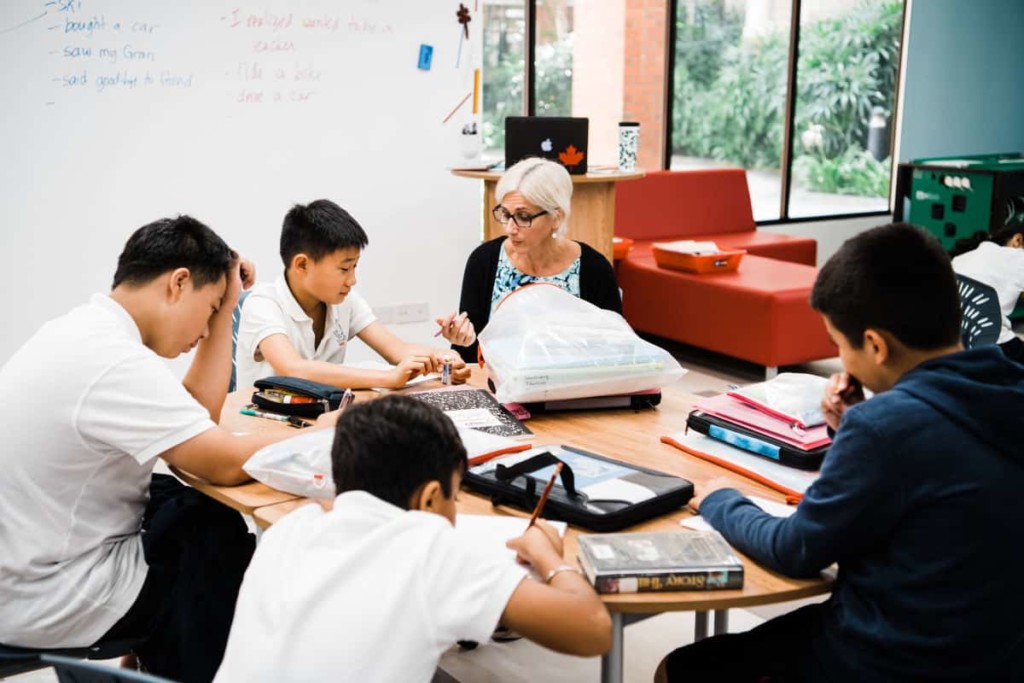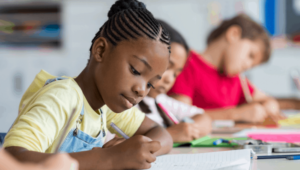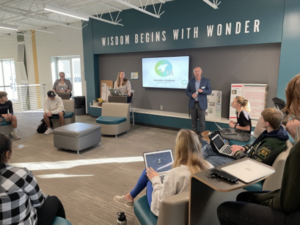Why Flexible Learning Environments?

By: Lauren Mehrbach and Chris Beingessner. This piece was originally published by Singapore American Schools
Last year, the SAS middle school worked with Fielding Nair International, an educational architecture firm, to renovate our sixth grade A-side team space to create a more flexible learning environment. This summer we are embarking on two more renovations, to 6B and 6C, to provide all of our students and faculty in sixth-grade access to a learning environment that is more flexible. As Jacobs and Alcocknote, “The most fundamental structures in our schools are often inhibitors to progress: our schedules, our physical spaces, the grouping patterns of learners, and the configuration of the personnel.” [1] As we work to provide a more personalized learning experience for our students, we find that physical space is limiting our ability to do so. As most adults in our community were served well by a traditional classroom environment, parents may have some questions about why we’d make this change.
How does a flexible learning environment relate to personalized learning?
“Flexible learning environments imply that the school adapts the use of resources such as staff, space, and time to best support personalization.”[2] So, what does personalization mean at SAS? It’s a combination of different structures, instructional strategies, and curricular approaches that allow a child to have access to what they need when they need it, to know what their next steps are in their learning, and to pursue areas of strength and interest. We use the terms flexible learning environments, customized pathways, and competency-based progressions to frame our understanding of the elements necessary to create a personalized experience for children.
What is a flexible learning environment?
When people think of a flexible learning environment, they often think only of the physical space. While it is true that the space is flexible in nature, there is much more to a flexible learning environment than just the physical floor plan or furniture choices. Modern flexible learning environments also address other elements of the learning environment such as how students are grouped during learning and how time might be used more flexibly during the day.

Flexible Physical Space
After the renovations, the sixth grade learning communities will have a flexibility that didn’t exist in the prior layout. Teachers and students can still configure the space to work in an environment similar to a traditional classroom if that is what is best for teaching and learning. However, we also know that not all learning involves 22 students in a single room at chairs and tables.
The new learning communities feature additional flexibility, creating spaces for groups of different sizes. There are small breakout rooms throughout the space so groups of students can work collaboratively. Some examples of what might happen in the smaller breakout spaces include activities like book partnerships and literature circles, math explorations, independent work, or collaborative work on a group presentation. A teacher might also pull a group of students into a smaller breakout space to re-teach a concept or provide a lesson that extends the current concept for students who have already grasped it. There is also the ability to open the space to bring all students on a grade level team together for large group activities. Some examples of when the space would be opened up include visitors making whole group presentations to the students, or sharing learning celebrations with the community. Sixth-grade math teacher Kris Munden sums it up this way: “In a traditional classroom with four walls, you’re restricted by those four walls. But here we don’t just have four walls, we have a bunch of walls that can open and close, so we can make the space fit what we need, rather than the space dictating what we can do.”
Flexible Time
There is much more to a flexible learning environment than the physical space. The flexibility extends to the use of time. All of our middle school core teams currently have the ability to flex their schedules and often do so. What do we mean by this? Each grade level has a block of time dedicated to our core program: English/Language Arts (ELA), math, science, social studies, and PE. Teams can reorganize that scheduled block in numerous ways to allow for different uses of the time. For example, they might revise the schedule, shortening classes, to create a block of time for a guest speaker or a home base activity. In sixth grade, they often use a schedule that shortens core blocks to create a flexible block of time after lunch. Students, with guidance from their teachers, identify what learning they want support in, and sign up for specific workshops to reinforce those skills during this block. Sometimes this might be remediation of a concept taught earlier in the day. Other times it will be an extension activity for students who have already grasped the concept from earlier in the day. At times, these blocks of time are also used to make explicit connections between the disciplines. Students may use this time to work on unit culminating projects that bring learning from multiple subjects together. These flexible blocks help students personalize their learning path, make connections across disciplines, and give them voice and choice in their learning.

Flexible Student Grouping
Traditionally, students are grouped together for a specific class at a specific time at the beginning of the year, and that grouping doesn’t change. A student’s classmates for ELA class, for example, remains static all year. However, this presumes that all students are the same, and need the exact same learning opportunities, at the exact same time. We know that all students are unique, and so this model has its limitations. Our teachers work closely together to plan for instruction based on student need. If a group of students needs extra time on a certain math concept, they are given that extra time during a flexible block, regardless of which math class they are scheduled into. Teachers examine students’ formative work on a regular basis to identify what learning they need next. Students are then grouped and regrouped in response to that data. The research affirms this, as well: “Using data to frequently adapt student grouping strategies to student needs is a key aspect of personalization; it is yet another way that instructors can be responsive to student needs and allow students to take various paths through content.”[3] Regardless of whether your child will be in a renovated space or not, teams of teachers across the middle school are finding ways to focus on flexible student grouping.
Does a flexible learning environment improve learning?
When teachers are working more collaboratively, they see connections across the skills and content from their specific courses. Our survey data shows that students working in the 6A space felt that their teachers knew what was going on in other classes, and the students were more likely to make connections between subjects than those not in a flexible learning environment. Interdisciplinary planning and conversations allow teachers to develop common language for skills that transcend subject areas. For example, writing a claim, supporting it with evidence, and using reasoning occurs in almost all subject areas, though not always in the exact same format. In a flexible learning environment, teachers more easily calibrate their language, and students make overt connections between subject area content and skills. While this may not show up explicitly in a standardized test result, students build their ability to see the world as inter-connected, which we know it is. In fact, the creation of disconnected subjects for schools goes back to 1892, when the National Education Association in New York “set public school institutions onto a pathway of discipline divisions.”[4] Since we don’t experience the world in discrete subjects, it makes sense that we set up opportunities so students won’t either.
Additionally, using flexible grouping and time allows students to be pushed further in their areas of strength and to get additional time and support in areas of challenge. A study by the Rand Corporation indicates “that compared to their peers, students in schools using personalized learning practices are making greater progress over the course of two school years, and that students who started out behind are now catching up to perform at or above national averages”.[5]
How does a flexible learning environment increase teacher effectiveness?
We all have partnerships in our lives that increase our effectiveness—maybe it is a co-worker who helps us see things at work we might not otherwise see, or a spouse, who shares responsibility for parenting. Working closely with someone on a common goal (increasing performance at work, or raising children to be good humans) enhances our lives. We make better decisions and perform better when we have a partner, or team to support us. The same happens with teachers. When they are working more collaboratively together, the benefits are substantial. Teachers learn from each other and get more regular feedback on their instructional practices. The level of transparency in a more flexible environment encourages teachers to work at the highest level possible. Some say that the flexible environment ensures they bring their “A game” daily. The teachers feel a sense of collective responsibility for all students’ learning.

Want to see it in action? You can get a glimpse of what our first middle school flexible learning environment is like here.
For more, see:
- Creating the Future of Learning: Singapore American School
- Empowering Learners: 10 Lessons on Innovation Leadership
- Powerful Learning Experiences: Why All Students Deserve Access
Stay in-the-know with all things EdTech and innovations in learning by signing up to receive the weekly Smart Update. This post includes mentions of a Getting Smart partner. For a full list of partners, affiliate organizations and all other disclosures, please see our Partner page.
[1] Jacobs, H. H., & Alcock, M. (2017). Bold moves for schools: How we create remarkable learning environments. Alexandria, VA, USA: ASCD.
[2] Wall, G. (2016). The Impact of Physical Design on Student Outcomes (New Zealand, Department of Education). Retrieved from https://www.education.govt.nz/assets/Documents/Primary-Secondary/Property/School-property-design/Flexible-learning-spaces/FLS-The-impact-of-physical-design-on-student-outcomes.pdf
[3] Pane, J., Steiner, E., Baird, M., & Hamilton, L. (2015). Continued Progress: Promising Evidence on Personalized Learning. doi:10.7249/rr1365
[4] Jacobs, H. H., & Alcock, M. (2017). Bold moves for schools: How we create remarkable learning environments. Alexandria, VA, USA: ASCD.
[5] Pane, J., Steiner, E., Baird, M., & Hamilton, L. (2015). Continued Progress: Promising Evidence on Personalized Learning. doi:10.7249/rr1365







0 Comments
Leave a Comment
Your email address will not be published. All fields are required.